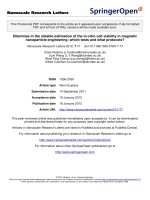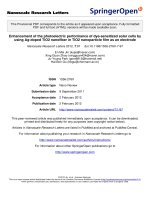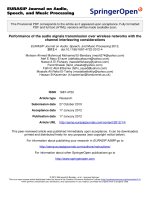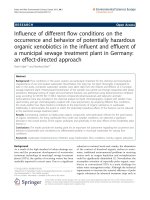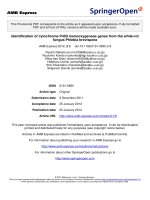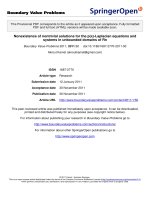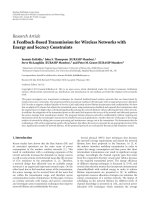Báo cáo toán học: " Performance of the audio signals transmission over wireless networks with the channel interleaving considerations" pot
Bạn đang xem bản rút gọn của tài liệu. Xem và tải ngay bản đầy đủ của tài liệu tại đây (5.52 MB, 50 trang )
This Provisional PDF corresponds to the article as it appeared upon acceptance. Fully formatted
PDF and full text (HTML) versions will be made available soon.
Performance of the audio signals transmission over wireless networks with the
channel interleaving considerations
EURASIP Journal on Audio, Speech, and Music Processing 2012,
2012:4 doi:10.1186/1687-4722-2012-4
Mohsen Ahmed Mahmoud Mohamed El-Bendary ()
Atef E Abou-El-azm ()
Nawal A El-Fishawy ()
Farid Shawki ()
Fathi E Abd-ElSamie ()
Mostafa Ali Refai El-Tokhy ()
Hassan B Kazemian ()
ISSN 1687-4722
Article type Research
Submission date 27 October 2010
Acceptance date 17 January 2012
Publication date 17 January 2012
Article URL />This peer-reviewed article was published immediately upon acceptance. It can be downloaded,
printed and distributed freely for any purposes (see copyright notice below).
For information about publishing your research in EURASIP ASMP go to
/>For information about other SpringerOpen publications go to
EURASIP Journal on Audio,
Speech, and Music Processing
© 2012 Mohamed El-Bendary et al. ; licensee Springer.
This is an open access article distributed under the terms of the Creative Commons Attribution License ( />which permits unrestricted use, distribution, and reproduction in any medium, provided the original work is properly cited.
1
Performance of the audio signals transmission over wireless networks
with the channel interleaving considerations
Mohsen Ahmed Mahmoud Mohamed El-Bendary
1
, Atef E Abou-El-azm
2
,
Nawal A El-Fishawy
2
, Farid Shawki
2
, Fathi E Abd-ElSamie
2
, Mostafa Ali
Refai El-Tokhy
1
and Hassan B. Kazemian
3
1
Department of Communications Technology, Faculty of Industrial
Education, Helwan University, Helwan, Egypt
2
Department of Electronics and Electrical Communications, Faculty of
Electronic Engineering, Menoufia University, Menouf 32952, Egypt
3
Intelligent Systems Research Centre, Faculty of Computing, London
Metropolitan University, London, UK
*Corresponding author:
Email addresses:
AEA: ,
NAE:
FS:
FEA:
MARE:
2
HBH:
Abstract
This article studies a vital issue in wireless communications, which is the
transmission of audio signals over wireless networks. It presents a novel
interleaver scheme for protection against error bursts and reduction the
packet loss of the audio signals. The proposed technique in the article is the
chaotic interleaver; it is based on chaotic Baker map. It is used as a
randomizing data tool to improve the quality of the audio over the mobile
communications channels. A comparison study between the proposed
chaotic interleaving scheme and the traditional block and convolutional
interleaving schemes for audio transmission over uncorrelated and correlated
fading channels is presented. The simulation results show the superiority of
the proposed chaotic interleaving scheme over the traditional schemes. The
simulation results also reveal that the proposed chaotic interleaver improves
the quality of the received audio signal. It improves the amount of the
throughput over the wireless link through the packet loss reduction.
Keywords: wireless networks; Bluetooth; fading channels; interleaving
techniques; mobility.
3
1. Introduction
With increasing utilization of wireless devices, especially Bluetooth devices,
there are two important factors for all wireless systems power efficiency and
efficient throughput. Bluetooth is designed to transfer data using ACL
packets and SCO packets for transferring audio streams [1, 2].
Bluetooth uses 64 kbps log PCM voice coding with either A-law or µ-law
compression, it is the simplest. It uses an 8-bit logarithmic scale. Although it
is simple to implement and it is useful in small applications. The log PCM is
less robust than the continuous variable slope delta. It is a voice coding
method, and is a delta modulation with variable step size. It is good noise
immunity, where the damaged packets are discarded without impacting on
sound quality [3–5]. In this study, the first voice coding log PCM is
considered, for simplicity of the simulations.
There are variety of methods exists for optimizing the transmission of
audio data, depending on the properties of the underlying network. In this
article, the fixed and mobile Bluetooth networks are assumed to have bursty
loss. This study is focused on the interleaving techniques to reduce the burst
error effects on the audio signals through distributing the burst errors
through a set of audio samples. Audio signals are transmitted as packets in
many Bluetooth applications. A packet is considered lost when it is
corrupted to the point that it cannot be used. When a packet is lost, a large
4
block of the digital bit stream is missing. The article proposed using
effective and powerful interleaver based on the chaotic Baker map. The
proposed chaotic interleaver reduces the number of lost packets as shown in
the results. So, the packet loss of the audio signal is decreased with the
proposed scenarios. Also, over the communications link which permits
retransmission the corrupted packets, using the proposed technique reduces
the number of retransmission requirement [6–8].
The rest of the article is organized as follows. In Section 2, Bluetooth
links are discussed. In Section 3, the proposed modifications are presented.
In Section 4, the simulation assumptions are given. The simulation results
are introduced in Section 5. Finally, the article is concluded in Section 6.
2. SCO, eSCO, and ACL links
Bluetooth supports both synchronous services such as voice traffic and
asynchronous services such as bursty data traffic. The specifications define
two different physical link types.
The SCO link is a symmetric, point-to-point link between the master and
a single slave in the piconet. The SCO link is typically used to support time-
bounded information like voice. The master can support up to three SCO
links to the same slave or to different slaves. On the SCO links, the packets
5
used include a CRC and are never retransmitted. The SCO packets have
been designed to support 64 kbps speech. There are three pure SCO packets,
namely, HV
1
, HV
2
, HV
3
, and one hybrid SCO (DV) packet [9, 10]. Also, the
enhanced SCO (eSCO) link permits retransmitting the dropped voice
packets. The packets of this link are EV
3
, EV
4
, and EV
5
Also, the extended
data rate (EDR) are eSCO, 2EV
3
, 2EV
4
, 2EV
5
, 3EV
3
, 3EV
4
, and 3EV
5
packets [11].
The ACL link provides a packet–switched connection between the master
and all active slaves in the piconet. A slave can send an ACL packet if it has
been addressed by the master in the previous slot. The ACL packets can be
retransmitted. Only a single ACL link can exist between a master and a
slave. There are encoded ACL packets such as DM
1
, DM
3
, and DM
5
, which
are protected with a rate of 2/3 FEC. Also, there are uncoded ACL packets
such as DH
1
, DH
2
, and DH
5
, which are not protected. These ACL are called
classic ACL packets. In the recent Bluetooth versions, there are other
packets that are specified such as 2DH
1
, 2DH
3
, and 2DH
5
or 3DH
1
, 3DH
3
,
and 3DH
5
, these packets are called EDR packets [12].
The simulations of this article concentrate on the ACL packets and EDR
eSCO packets through many scenarios. The proposed technique improves
the quality of the received audio signals and reduces the dropped packets
over the bursty channel.
6
3. Proposed modifications
In this article, two audio files are used, file-1 which meets the
specification audio transmission over Bluetooth network. The second audio
file-2 has different properties as shown in the simulation assumption section.
First, the size of audio file-1 is 32 kbytes. This file will be segmented to
small packets. There are many classic (DH
1
) and EDR (2DH
1
& 2DM
1
)
packets used for transferring audio files. For example, in the DH
1
packets,
each one of these packets contains 30 bytes. The duration of this file is 4 s.
Number of packets (file-1) = 32 kbytes/30 bytes ≈ 1066 packets.
Number of audio portions (file-1) = 4 s/3.75 ms ≈ 1066 portion.
Second, the size of audio file-2 is 92 kbytes. This file will be segmented
to small packets. Each one of these packets contains 30 bytes. The duration
of DT audio file is 8 s.
Number of packets (file-2) = 92 kbytes/30 bytes ≈ 3066 packets.
Number of audio portions (file-2) = 8 s/3.75 ms ≈ 2133 portion.
As shown, audio file-1 matches Bluetooth specification in its properties.
But, the second audio file-2 does not meet Bluetooth specification. It is used
with the long packets simulations.
7
In the simulation, different interleaving techniques are applied on the
audio signal before transmission process. The two traditional types, bit-level
interleaver and the convolutional interleaver, are used. Figure 1 shows the
method of data reading in case of bit-level interleaver.
The second type is the convolutional interleaver that are introduced as no
block deterministic interleavers that were investigated in some
communication systems due to applying less memories in their structures
compared with the block interleavers [13]. Convolutional interleavers are
constructed by T parallel lines; each line has different number of memories
from other line. The construction of convolutional interleaver is shown in
Figure 2. This figure illustrates the convolutional interleaver with period
T = 4 and space value M = 1 based on arithmetic sequence, the overall
number of memories (delay) for the interleaver (T, M) is given in Equation 1
[13]
1
2 ( 1)
T
i
i
S s M M T M
=
= = + + + −
∑
L
(1)
( 1)
6 (The simulation case 1 , 4)
2
T T M
M T
−
= = = =
There is the last one of the proposed scenarios, which is the chaotic
randomizing. It is performed using the chaotic Baker map. The Baker map is
a chaotic map that generates a permuted version of a square matrix. In its
8
discretized form, the Baker map is an efficient tool to randomize a square
matrix of data. The discretized map can be represented for an M × M matrix
as follows [14–21]
( )
+−+−=
i
M
i
n
M
ss
M
i
n
i
n
M
s
i
Mr
i
n
M
srB mod,mod),(
(2)
where
),( srB
are the new indices of the data item at
),( sr
, M
i
≤ r < M
i
+ n
i
,
0 < s < M and M
i
= n
1
+ n
2
+ ⋅⋅⋅ +n
i
.
In steps, the chaotic permutation is performed as follows:
1. An M × M square matrix is divided into k rectangles of width n
i
and
number of elements M.
2. The elements in each rectangle are rearranged to a row in the
permuted rectangle. Rectangles are taken from right to left beginning with
upper rectangles then lower ones. Inside each rectangle, the scan begins
from the bottom left corner toward upper elements.
Figure 3 shows an example of the chaotic encryption of an 8 × 8 square
matrix. The secret key is S
key
= (n
1
, n
2
, n
3
) = (2, 4, 2).
This technique is employed in the simulation as a data randomizing tool.
It is employed in two forms; it is applied on the audio file to randomize the
whole audio file. Also, it is applied on the packet-by-packet basis for
9
randomize the encoded packets. The simulation results reveal that the
proposed technique improves the quality of the received audio signals.
4. Simulation assumptions
In this section, the simulation environment used for carrying out the
computer simulation experiments is described. An important assumption
used in the simulation is that a packet is discarded if there is an error in the
access code, The Header, or Payload field, was not corrected using the error
correction scheme. This is a realistic assumption to simulate the real
Bluetooth systems’ operation [22]. This assumption is employed to measure
the number of corrupted packets, but the received packets are recollected
after the decoding process for reconstruct the received audio signal.
In the simulation, HV
3
packet is replaced by DH
1
(ACL packet). The
length of DH
1
uncoded packet is 240 bits. There are two types of audio files
used in the simulation: the audio file-1 (32 kbytes). Its characteristics are bit
rate 64 kbps, audio sample size 8 bit, channel 1 mono, audio sample rate
8 kHz, and audio format PCM; and the audiofile-2 (92 kbytes), whose file
characteristics are as follows: bit rate 88 kbps, audio sample size 8 bit,
channel 1 mono, audio sample rate 11 kHz, and audio format PCM. Tables 1
and 2 show the properties of the audio files [23, 24].
10
In the simulation, there are many different packet formats employed for
audio transmission, and. also a block-fading channel is assumed. It is a slow
and frequency nonselective channel, where symbols in a block undergo a
constant fading effect, meaning that the Doppler spread equals zero (F
d
= 0).
Also, the Jakes’ model is utilized for simulating the correlated Rayleigh
fading channel. The mobile Bluetooth device velocity is up to 20 mile/h, and
the carrier frequency is 2.481 GHz. The phase difference between the paths
is given from Equation 2. The Doppler spread is expressed in Equation 3
[25].
2
2
cos
c
v t
l
π
π
φ θ
λ λ
∆
∆
∆ = =
(3)
1
cos
2
c
d
v
F
t
φ
θ
π λ
∆
= =
∆
(4)
The obtained binary data are used to build the audio file again. The
waveform of received audio signal is compared to original waveform of
transmitted signal to evaluate the effects of the proposed modifications. In
this study, the audio signal is transmitted and interleaved using the bit-level
interleaving and the convolutional interleaving over the fading channels.
Figures 4 and 5 show the original waveform of audio files 1 2, respectively.
MATLAB was used for carrying out the simulations of different scenarios.
The simulation results have been acquired by the transmission of audio files
over different SNR values.
11
5. Simulation results
In this section, the performance of the proposed transmission audio signal
through ACL link over correlated and uncorrelated Rayleigh fading channels
is studied through simulation. For the comparison purpose, using different
scenarios, non-interleaving, bit-level interleaver, convolutional interleaver,
and the proposed chaotic randomizing techniques are also simulated. In the
case of correlated Rayleigh fading channel, the Jakes’ model is used in the
simulation.
In this section, there are many simulation scenarios devoted for
evaluating the proposed scenarios of the audio signal transmission.
5.1. Short classic packets DH
1
This simulation studies the interleaving effects on the received waveform of
audio signal over Rayleigh fading channel. The file-2 is transmitted over
uncorrelated Rayleigh fading channel using the DH
1
packets. Figure 6
illustrates the waveform of received audio signal at SNR = 25 dB. It is clear
that using the interleaving improves received waveform at the same SNR
value.
12
As shown in Figure 6, the bit-level interleaving scenario performs better
than other scenarios in this simulation over an uncorrelated Rayleigh fading
channel.
The previous computer simulation is repeated over a correlated fading
channel. This simulation is devoted to indicate the velocity (V
c
) of the
mobile terminal on the waveform of the received audio signals. The
simulation utilized the Jakes’ model communication channel. The result of
this simulation is given in Figure 7, this figure shows the waveform of the
received audio signal with assuming the velocity of the mobility is 3 and
10 mile/h.
The result of this simulation reveals that the mobility of the transmitter
increases the distortion of the received audio signal. Also, the audio signal
transmission needs strong interleaving technique to spread the errors and
reduce the bad mobility effects.
In the following simulation, the interleaving effect on the received
waveform of audio signal over uncorrelated fading channel is studied. The
file-1 is transmitted using the uncoded classic DH
1
packets. Figure 8
illustrates the waveform of received audio signal at SNR = 20 dB. It is clear
that using the interleaving improves received waveform at the same SNR
value. The audio file-1 characteristics match the Bluetooth specifications as
mentioned previously. As shown in this simulation results, the waveforms of
13
the received audio signals clear that the bit-level interleaver performs better
than the convolutional interleaver. Figure 8 also reveals that the
convolutional interleaver enhances the waveform of the received audio
signal more than the no interleaving scenario.
In the last simulation of this section, the audio file-2 is transmitted over a
correlated Rayleigh fading channel [V
c
= 10 mile/h] using the DH
1
packets.
Figure 9 illustrates the waveform of received audio signal at SNR = 20 dB.
It is clear that the convolutional interleaver scenario performs better than
other scenarios over a correlated fading channel.
In the previous simulation, the performance of the audio signals
transmission is studied over uncorrelated and correlated fading channels
with different mobility velocities. These simulation scenarios indicated that
there are bad effects of the mobility on the received audio signal waveforms.
Also, it reveals that the interleaving techniques improve the audio
waveforms. In the following section, the simulation evaluates the proposed
interleaving technique which is the chaotic randomizing technique, based on
the chaotic Baker map.
5.2. Randomizing technique
In this section, the simulation results of the proposed technique are
14
presented. The simulation senarios have been carried out for different types
of Bluetooth packets; 2DH
1
and 2DM
1
with the different signal-to-noise
ratios (SNRs). The peak SNR, the absolute number of lost frames (NLF),
NLF percentage (NLF %), bit error rate (BER), and the correlation
coefficient (Cr) are employed for measuring the correlation between the
original and the received images; the mean square error (MSE) and the
throughput (T) are used for performance evaluation of the Bluetooth network
in the different simulation scenarios [26]. The MSE is the cumulative
squared error between the received audio signal and the original signal. The
mathematical formula for MSE is given in Equation 4 [27].
[ ]
2
1 1
1
( , ) '( , )
M N
y x
MSE I x y I x y
MN
= =
= −
∑∑
(5)
The throuput is defined as [28]
(
)
( )
tx
PERP
T
l
1
1
+
−
= (6)
where P
l
is the payload length, PER is the packet error rate, x is the
number of time slots occupied by the Bluetooth packet, and t is the duration
of the Bluetooth time slots.
In the following, the EDR Bluetooth packets are used for transmitting audio
signal over mobile Bluetooth network. The proposed Bluetooth terminal
velocity (V
c
) is 10 and 3 mile/h and the frequency carrier is 2.46 GHz. As
shown in the following results, with increasing the velocity of Bluetooth
15
terminal, the performance is degraded and the effect of channel on the
transmitted signal is increased. Figure 10a gives the frame error rate (FER)
of standard 2DH
1
and proposed 2DM
1
packets which is used for transmitting
the audio signal with many proposed cases at V
c
= 3 mile/h. Figure 10b gives
FER at V
c
= 10 mile/h. Figure 11 gives the comparison of NFL and FER
with the velocity variations with the standard uncoded packets.
From the previous section, the following is concluded: Over mobile
Bluetooth network, the quality of audio transmission is decreased with V
c
increasing. Traditional block interleaving of audio file is inefficient over
mobile network. The proposed encoded EDR packets with block
interleaving of encoded packet performs better than encoded packets
(2DM
1
), which represents 2EV
3
voice packets. The performance of standard
packets (2DH
1
) is very bad compared with proposed cases.
Also in this section, the proposed different scenarios for studying the
audio signal performance with the proposed randomize techniques are
presented. The results of these scenarios are shown in Figure 12. The results
of this simulation indicate the effects of the mobility on the audio signal. As
shown in this figure in case of V
c
= 3 mile/h, the NFL of the whole
simulation scenarios are much closed but with V
c
= 10 mile/h its
performance became different.
16
As shown in the previous results, the randomize technique which is based
on the chaotic Baker map concepts scenario performs better than other
technique. From these results, the proposed chaotic interleaver packet by
packet basis is presented as a novel efficient interleaver. The proposed
technique is evaluated through two groups of simulations according to the
type of packets which is employed for the proposed technique testing. These
packets are the uncoded 2DH
1
and encoded 2DM
1
EDR packets.
5.3. The mobility effects on the audio transmission performance
This section is devoted for studying the effects of the mobility of the
wireless ad hoc network device (V
c
) on the transmitted packets and the
received audio signals. In this computer simulation, the v is 1 up to
20 miles/h. Figures 13, 14, and 15 show the NLF, Cr, and MSE variation
with the channel SNR with the shortest EDR uncoded packets 2DH
1
,
respecteively. It is clear that with increasing the V
c
of the terminal the NLF
increased and the correlation between the original audio signal and the
received signal is decreased. As shown in Figure 13, the MSE increased with
the velocity increasing. Figure 16 gives the throughput variation with the
different velocity of the mobility. So, these results indicate the mobility
effects on the different metric of the perfromance evaluation.
The previous results reveal that it should be finding efficient technique for
17
reducing the bad effect of the mobility on the audio signal transmission. In
the following simulation scenarios, number of scenarios are proposed for
this purpose. The proposed scenarios are applied on different packet lengths.
These scenarios depend on that the interleaving technique is an efficient
method for anti-fading, and is raised to solve serious long burst interference
in some fading channels. The proposed scenarios are tested in two groups of
the EDR packets with different velocities with employing the widely
accepted Jakes’ model to modelate the simulation environment. Figure 17
gives the waveforms of the received audio signal with different V
c
of the
mobility.
5.4. Audio signal transmission using 2DH
1
and 2DM
1
packets
This section is devoted to test the efficiency of audio transmission using
the short uncoded 2DH
1
and encoded 2DM
1
EDR packets with the different
scenarios. In the first computer simulation, the audio signal has been
transmitted over a correlated fading channel with an SNR = 15 dB. The
results of this simulation are shown in Figure 18. From these results, it is
clear that the effect of the proposed randomizing interleaving based on the
chaotic Baker map is better than that of the other schemes. As shown in
Figure 18, the waveform of the received audio signal is improved with the
proposed scenarios. The proposed velocity of the mobility in this simulation
18
is V
c
= 3 mile/h.
Figures 19 and 20 show the variation of the Cr and the MSE of the
received audio signals with the channel SNR, respectively. These figures
reveal that the proposed chaotic interleaver improves the quality of the
received audio signal. It increases the correlation and decreases the error
between the received and the original signals. Figure 21 indicates the
effectiveness of the proposed scenarios on the error performance through the
BER variation with the channel SNR. As shown in this figure, the error
spreading capability of the proposed chaotic randomizing technique
enhances the error performance over the mobile channel for the audio signal
transmission. Figure 22 gives the NLF % variation with the channel SNR.
The effect of the velocity on the dropped packets is indicated in Figure 15
for the uncoded 2DH
1
EDR packets, in this simulation the dropped packets
are calculated as percentage where the audio file is segmented and
transmitted through uncoded and encoded packets.
In the previous simulation, the mobility effect is studied on the audio
signal transmission in a fixed and mobile communication channels in many
of scenarios. Also, it evaluates the proposed chaotic interleaver on the whole
audio file and packet-by-packet basis. The simulation results reveal that the
ACL link improves the throughput of the audio signal. Also, the interleaving
techniques enhance the received audio signals. The proposed data
19
randomizing tool performs better than traditional interleavers over the
mobile Bluetooth network. As shown in the results, the MSE and Cr of the
received audio signals are improved by applying the proposed scenario of
the chaotic randomizing technique.
6. Conclusions
In this article, the transmission of voice using ACL link is discussed. In the
simulation two different audio files and different interleaver types were
used. The simulations were carried out over Rayleigh correlated and
uncorrelated fading channels. The simulation results reveal that over
uncorrelated fading channel the best choice is bit-level interleaver in case of
the classic uncoded packets, whereas over correlated fading channel, the
convolutional interleaver is efficient. Also, the effectiveness of the
interleaving techniques is inefficient with audio file that has higher bit rate
than 64 kbps. The ACL link is an efficient for carrying voice unless there is
a need for high-quality voice. Using this link for carrying voice also leads to
improving the throughput. ACL link is a suitable choice for carrying voice
specially with using interleaving technique. The article proposes a novel
data randomizing tool for enhance the quality of the audio signal
transmission over ACL link. The proposed chaotic technique performs better
than the traditional interleaver over the mobile channel. It can be then
20
applied on the EV packets and on the mobile Ad hoc network. It reduces the
packet loss of the transmitted audio file and also it is an efficient tool for
decreasing the mobility bad effects on the transmitted audio signals.
Competing interests
The authors declare that they have no competing interests.
References
[1]. MAM Mohamed, A Abou El-Azm, N El-Fishwy, MAR El-Tokhy, FE
Abd El-Samie, Optimization of bluetooth packet format for efficient
performance. Prog. Electromagn. Res. M. 1, 101–110 (2008)
[2]. IEEE 802.15.4 Wpan-Ir Task Group,
[3]. J Kardach, Bluetooth architecture overview. Intel Technol J, Q2, 1–7
(2000)
[4]. IEEE 802.15 Wpan taskgroup 1 (tg),
[5]. P Johansson, R Kapoor, M Kazantzidis, M Gerla, Bluetooth: an enabler
for personal area networking, IEEE Netw. Mag. September/October, 28–37
(2001)
21
[6]. IEEE 802.11, the working group setting the standards for wireless
LANS,
[7]. W Feng, A Nallanathan, HK Garg, Introducing packet segmentation for
IEEE 802.11b throughput enhancement in the presence of Bluetooth, in 59th
Vehicular Technology Conference VTC, pp. 2252–2256, 17–19 May, 2004
[8]. S Galli, D Famolari, T Kodama, Bluetooth: channel coding
considerations, in IEEE Vehicular Technol Conf, 2004
[9]. MAM El-Bendary, A Abou El-Azm, N El-Fishwy, MAR El-Tokhy, FE
Abd El-Samie, H Kazimian, F Shawki, An efficient chaotic interleaver for
image transmission over IEEE 802.15.4 Zigbee network. J. Telecommun.
Inf. Technol. 2, 67–73 (2011)
[10]. L-J Chen, T Sun, Y-C Chen, Improving Bluetooth throughput using
FEC and interleaving, in International Conference on Mobile Ad Hoc sensor
Networks, Hong Kong, pp. 726–736, 2006
[11]. MAM Mohamed, A Abou El-Azm, N El-Fishwy, MAR El-Tokhy, FE
Abd El-Samie, F Shawki, Bluetooth performance improvement with existing
convolutional codes over AWGN channel, in 2nd International Conference
on Electrical Engineering Design and Technologies (ICEEDT’08)
Transaction No. 537, Hammamet, Tunisia, November 8–10, 2008
[12]. N Golmie, RE Van Dck, A Soltanian, Interference of Bluetooth and
IEEE 802.11: simulation modeling and performance evaluation, in
22
Proceedings ACM Int. Workshop on Modeling, Analysis, and Simulation of
Wireless and Mobile Systems, Italy, 2001
[13]. S Vafi, T Wysocki, Performance of convolutional interleavers with
different spacing parameters in turbo codes, in Proc. 6th Australian
Workshop on Communications Theory, pp. 8–12, 2005
[14]. W Lu, H Tao, F Chung, Chaos-based spread spectrum robust
watermarking in DWT domain, in Fourth International Conference on
Machine Learning and Cybernetics, Guangzhou, 18–21 August 2005
[15]. FE Abd El-Samie, ES Hassan,·X Zhu, SE El-Khamy, MI Dessouky,
SA El-Dolil, A chaotic interleaving scheme for the continuous phase
modulation based single-carrier frequency-domain equalization system.
Wirel. Pers. Commun. 62(1), 183–199, Published online 11 June 2010
[16]. B Jovic, C Unsworth, Chaos-based multi-user time division
multiplexing communication system. Commun. IET 1(4), 549–555 (2007)
[17]. R Matthews, On the derivation of a chaotic encryption algorithm.
Cryptologia, XIII(1), 29–42 (1989)
[18]. KS Deffeyes, Encryption system and method. US Patent no. 5001754,
March 1991
[19]. J Fridrich, Symmetric ciphers based on two-dimensional chaotic maps.
Int. J. Bifurcat. Chaos 8, 1259–1284 (1998)
[20]. J Fridrich, Image encryption based on chaotic maps, in Proc. IEEE Int.
Conf. Syst. Man Cybern., pp. 1105–1110, 1997
23
[21]. Q Qian, Z Chen, Z Yuan, Video compression and encryption based-on
multiple chaotic system, in Proceedings of The 3rd International Conference
on Innovative Computing Information and Control (ICICIC'08)
[22]. TY Chui, F Thaler, WG Scanlon, A novel channel modeling technique
for performance analysis of Bluetooth baseband packets, in Proceedings of
the IEEE ICC Conference. New York, 2002
[23]. JC Haartsen, S Zürbes, Bluetooth voice and data performance in
802.11 DS WLAN environment. Ericsson Report, 1999
[24]. Alpha Concept Group, Wideband Direct Sequence CDMA (WCDMA)
Evaluation Document (3.0), Tdoc SMG 905/97, Madrid, Spain, December
15–19, 1997
[25]. A Conti, D Dardari, G Paolini, O Andrisano, Bluetooth and IEEE
802.11b coexistence: analytical performance evaluation in fading channels.
IEEE Trans. Sel. Areas Commun. 21(2), 259–269 (2003)
[26]. WC Jakes, Microwave Mobile Communications (John Wiley & Sons,
Inc., New York, 1975), ISBN 0-471-43720-4
[27]. J Aldrich, Correlations genuine and spurious in Pearson and Yule. Stat.
Sci. 10, 364–376 (1995).
[28]. A Zanella, M Zorzi, Throughput and energy efficiency of bluetooth v2
+ EDR in fading channels, in IEEE Communications Society Subject Matter
Experts for Publication in the WCNC 2008 Proceedings
24
Figure 1. Bit-level interleaver of audio file after transforming to binary
data. (a) Audio file in binary data form. (b) Audio file after bit-level
interleaving.
Figure 2. Convolutional interleaver structures.
Figure 3. Chaotic encryption of an 8 ×
××
× 8 matrix. (a) Original square
matrix. (b) Chaotic encrypted matrix.
Figure 4. Original waveform of file-1.
Figure 5. Original waveform of file-2.
Figure 6. Received audio signal of file-2 waveform over uncorrelated
fading channel at SNR = 25 dB. (a) No interleaving. (b) Bit-level
interleaving. (c) Convolutional interleaving.
Figure 7. Received audio file-2 signal waveform over a correlated fading
channel at SNR = 25 dB. (a) V
c
= 3 mile/h. (b) V
c
= 10 mile/h.
Figure 8. Received audio signal of file-1 waveform over uncorrelated
fading channel at SNR = 20 dB. (a) No interleaving. (b) Bit-level
interleaving. (c) Convolutional interleaving.
Figure 9. Received audio signal of file-1 waveform over a correlated
fading channel (V
c
= 10 mile/h) at SNR = 20 dB. (a) No interleaving. (b)
Bit-level interleaving. (c) Convolutional interleaving.

